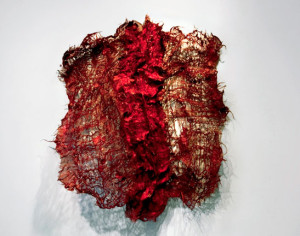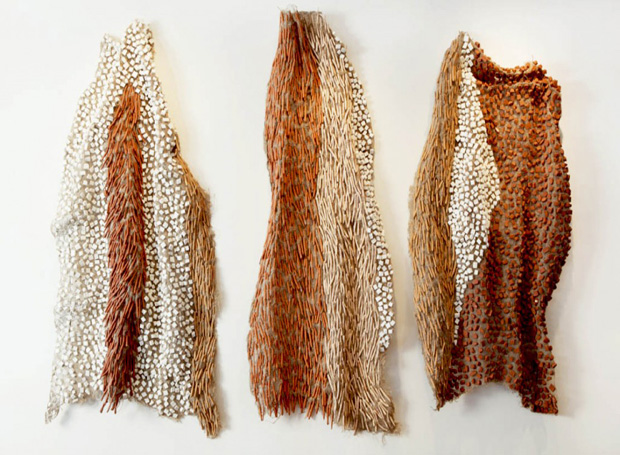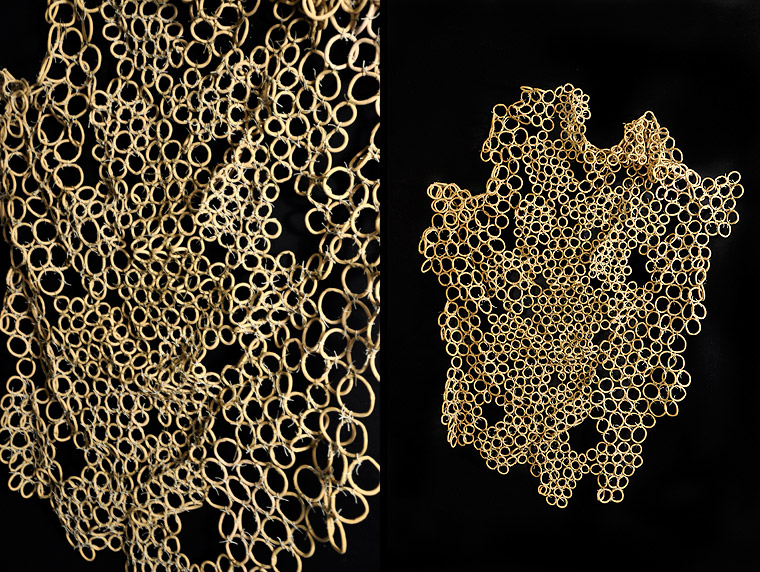
Nnenna Okore in Interwoven Histories
October Gallery London
From October 30 till November 29.
Memory Lane.
a. Nnenna Okore’s art is inspired by the use of found objects, and by close attention to natural textures and forms. Using basic materials such as clay, newspaper, wax and rope, her tactile and highly evocative sculptures take on dramatic and unanticipated forms. Her work celebrates the transformation of discarded materials into cultural objects and spaces and brings a critical focus to bear on the consumption and recycling cultures in parts of Nigeria. She applies various repetitive and labour-intensive techniques, like weaving, twisting, sewing, dyeing, waxing and rolling, which were learned by watching villagers perform everyday tasks. These processes accentuate colours, textures and other visceral qualities of her sculptures.
Mentored by the renowned sculptor El Anatsui, Nnenna’s highly tactile works are shaped into striking forms, when displayed.
 Earthbound, 2014.
Earthbound, 2014.
Currently she is working with shapes that explore or are inspired by intimate spaces, shelters, architectural and natural environments. Her work has been exhibited at the headquarters of Channel 4, London, in connection with the Big 4 Project. In September 2008, her works were featured in the inaugural exhibition Second Lives: Remixing the Ordinary, at the Museum of Arts and Design in New York. Her recent solo exhibitions include October Gallery, London, 2008, the Chicago Cultural Center, 2009 and the Goethe Institute, Lagos, Nigeria 2009. She will have a second solo exhibition at October Gallery, London in May 2011.
 Ulukububa, 2008.
Ulukububa, 2008.
Semmi: You have a background in painting. What made you want to start working in sculpture?
Nnenna: Right from my childhood days, I was always attracted to the spatially composed, tactile, and organic environments. Then, even as a young painter, I was sculpturally minded. My paintings characteristically had a third dimension with supple buildups of paint, soil, rope, fabric, and other found objects. When these accumulative methods no longer satisfied my sensorial delight, I decided to embark on a full journey of immersing myself in [the field of] sculpture through my graduate degrees.
S: You are known for using recycled materials. Why do you like working with discarded materials?
N: The thrill is in the ability to create intriguing or meaningful forms from useless articles… it’s equally satisfying to repurposing urban recyclia, knowing that in my own little way, I am drawing attention to problems of excessive production and material wastefulness, in addition to impacting the global discourse on environmental conservation.
 Everything Good Shall Come to Pass, 2014.
Everything Good Shall Come to Pass, 2014.
S: Do have a favorite material to work with?
N: Yes, I am totally enthralled by paper — old newspapers, recycled print paper, cardboard paper, etc. The range of possibilities with this material, in terms of applicable processes, is limitless. For instance, as a material, it can be folded, twisted, shredded, pulped, braided, sewed, or self laminated. And these attributes keep me totally absorbed.
As a rule, I try not to impose greatness on an idea from the onset of a creative project, because it is in the making process that the mediums and ideas interact and connect. And this is especially true for sculptural processes, where the result could either hit the mark or spin unexpected out of control. For this reason, I generally refrain from getting fixated with my ideas until its completion. Open-mindedness, also, to an extent guarantees no real failures.
(from Art in Fact, May 19, 2014. Interview Semmi W.)

